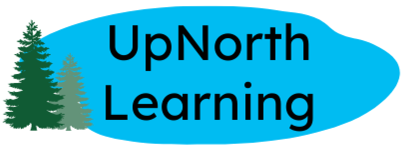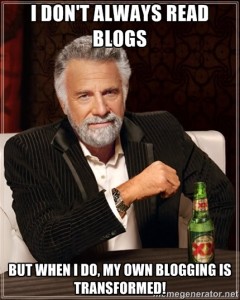After a summer off, I am returning to blogging with a new, and I hope, lasting, enthusiasm. This summer when I wasn’t adding anything to my blog, I dedicated time to reading the blogs of other educators and thinkers whom I admire. I guess I would say that I went looking for other mentor texts to explore a greater variety of topics, styles and techniques. Here’s what I learned.
Reading Blogs
Subscribing
When I set out to make reading the blogs of others a regular habit, I realized that first I would need a method to keep up with blog posts. Going to 30+ individual blogs each day is not efficient, and for me, the thought of receiving emails every time a blogger posts is overwhelming. I have had a free Feedly account for quite some time, but I made the $5.00 per month leap to a paid account in order to use IFTTT. IFTTT – If This Then That – is an automated system that allows simple coding to manage multiple accounts. I found a recipe in IFTTT that sends a daily digest of all new blog posts I subscribe to on Feedly to my email every day. From that email, I can read titles and then visit quickly and easily the posts I wish to read. I am able to read more broadly and catch things that otherwise might not have made it into my Twitter stream or email. Feedly now has a sharing feature, so here are my education blogs. What education blogs am I missing? Please let me know in the comments so I can continue to grow my blog list.
Reading as an audience member
I read the blogs of others to learn. My blog reading is narrow in that regard: I read the blogs of educators or people with insight into the field of education. I’ll admit, I throw in the occasional blog of a writer or artist as well because good teaching requires creativity and because I fancy myself an amateur writer on good days. As a reader, I am looking for new ideas for incorporating technology into my classes in meaningful ways. I am looking for fresh ideas for implementing more student voice and choice into my English classes. I am looking not just for the practical ideas for my classes, but for those ideas which push my thinking about pedagogy.
Like every reader, my blog reading is limited by a hectic life. I read blog posts in the morning before my day begins, in the evenings when my daily digest arrives, and in snippets throughout the day. I appreciate blog posts that I can read in less than a minute (like this one from Richard Byrne) and still find myself inspired by a new idea. I’m captivated by longer posts, but they must grab me from the start (like this post on raising “adaptive, reflective, and confident” writers, featured on the Teachers, Profs, Parents: Writers Who Care Blog) . The more I have read this summer, the more I have grown to like posts in a series format, like these from Alice Keeler. The brevity of each individual post works when I have a minute here or there, and the idea that there are additional posts on the topic or theme intrigues me to return to the post later to dig deeper.
In addition, I have come to appreciate bloggers for their ability to keep it real. Sustainability is clearly an issue for all bloggers, especially those who blog about their practices in the available time that their “real” job affords them. I was glad to hear Amy Rasmussen talk about “winding down to gear up” on the Three Teachers Talk blog and I was inspired by Dana Huff’s anniversary post celebrating ten years of her blog. She and other bloggers, like Kevin Hodgson, have been using the Slice of Life strategy, initiated by the bloggers at Two Writing Teachers, to capture an ordinary moment of their professional lives and share it via their blogs. That’s honesty! As a member of the audience, I am inspired by teachers around the globe who write to reflect, process, connect, improve, and share the practices in their classrooms every day.
Reading as a writer
As I read more this summer, I also stepped outside of my role as an audience member to read blogs as a writer. Just as an actor cannot watch a movie without studying the craft of fellow actors, I decided to read blogs with an eye toward the craft of fellow bloggers. The pool of educational bloggers is vast and the work they do is incredible. Some bloggers are prolific – producing intriguing posts several times per week. Others might not post as frequently, but when they do, their posts are rich in language and resonant in tone. These posts capture the audience immediately – a requirement in the frantic world of social media and blogs – and they draw the reader in toward a compelling conclusion. The best blog posts contain the right balance of images to enhance thinking yet not distract from the writing. Memorable posts also have sufficient links to explore further information.
Renewing my Writing
Studying the blogs of those who are experts at it can feel daunting. Toward the end of the summer, I started regretting my decision and lamenting the fact that I would have nothing so wise and well-constructed to say in my own blog. Luckily for me, it was just at that moment that Richard Byrne posted his series on blog-writing and in particular this wonderful post. In it, Byrne advises bloggers to “share what is obvious.” He cites Derek Sivers for this idea, which only serves to remind me that even in the world of blogging, we all “stand on the shoulders of others” to create something new.
And so it is that I return to my blog with a host of new ideas and inspirations to guide me. I have a page of brainstormed ideas for the coming months, but I also hope to try the Slice of Life strategy and write about what is obvious to me. It’s good to be blogging again. : )



